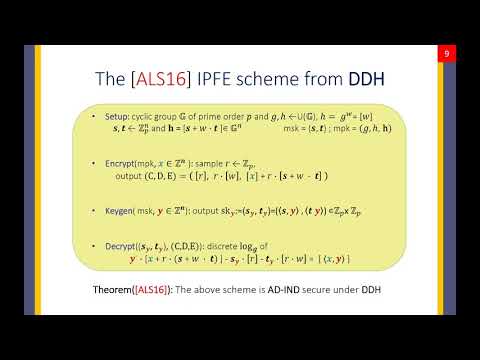CryptoDB
Adaptive Simulation Security for Inner Product Functional Encryption
| Authors: | |
|---|---|
| Download: | |
| Abstract: | Inner product functional encryption ( $${mathsf {IPFE}}$$ ) [ 1 ] is a popular primitive which enables inner product computations on encrypted data. In $${mathsf {IPFE}}$$ , the ciphertext is associated with a vector $$varvec{x}$$ , the secret key is associated with a vector $$varvec{y}$$ and decryption reveals the inner product $$langle varvec{x},varvec{y} angle $$ . Previously, it was known how to achieve adaptive indistinguishability ( $$mathsf {IND}$$ ) based security for $${mathsf {IPFE}}$$ from the $$mathsf {DDH}$$ , $$mathsf {DCR}$$ and $$mathsf {LWE}$$ assumptions [ 8 ]. However, in the stronger simulation ( $$mathsf {SIM}$$ ) based security game, it was only known how to support a restricted adversary that makes all its key requests either before or after seeing the challenge ciphertext, but not both. In more detail, Wee [ 46 ] showed that the $$mathsf {DDH}$$ -based scheme of Agrawal et al. (Crypto 2016) achieves semi-adaptive simulation-based security, where the adversary must make all its key requests after seeing the challenge ciphertext. On the other hand, O’Neill showed that all $$mathsf {IND}$$ -secure $${mathsf {IPFE}}$$ schemes (which may be based on $$mathsf {DDH}$$ , $$mathsf {DCR}$$ and $$mathsf {LWE}$$ ) satisfy $$mathsf {SIM}$$ based security in the restricted model where the adversary makes all its key requests before seeing the challenge ciphertext. In this work, we resolve the question of $$mathsf {SIM}$$ -based security for $${mathsf {IPFE}}$$ by showing that variants of the $${mathsf {IPFE}}$$ constructions by Agrawal et al. , based on $$mathsf {DDH}$$ , Paillier and $$mathsf {LWE}$$ , satisfy the strongest possible adaptive $$mathsf {SIM}$$ -based security where the adversary can make an unbounded number of key requests both before and after seeing the (single) challenge ciphertext. This establishes optimal security of the $${mathsf {IPFE}}$$ schemes, under all hardness assumptions on which it can (presently) be based. |
Video from PKC 2020
BibTeX
@article{pkc-2020-30282,
title={Adaptive Simulation Security for Inner Product Functional Encryption},
booktitle={Public-Key Cryptography – PKC 2020},
series={Public-Key Cryptography – PKC 2020},
publisher={Springer},
volume={12110},
pages={34-64},
doi={10.1007/978-3-030-45374-9_2},
author={Shweta Agrawal and Benoît Libert and Monosij Maitra and Radu Titiu},
year=2020
}

